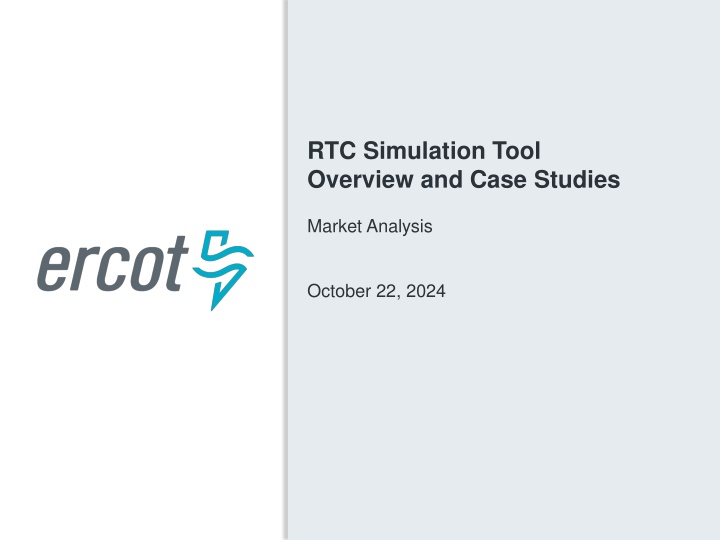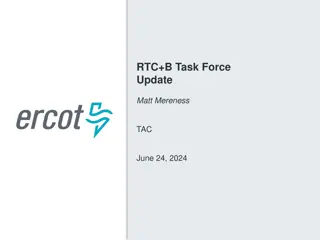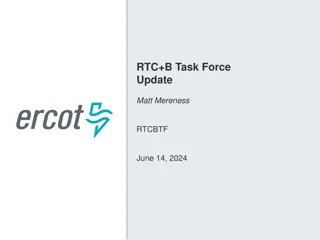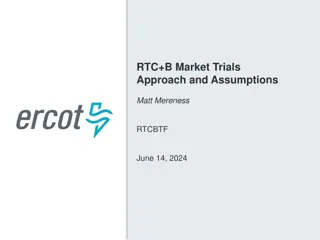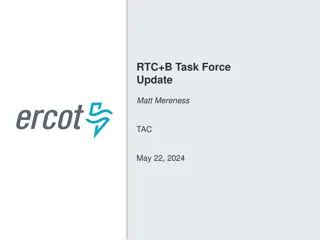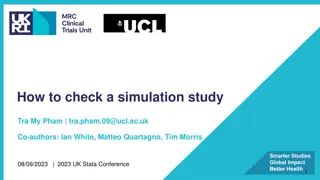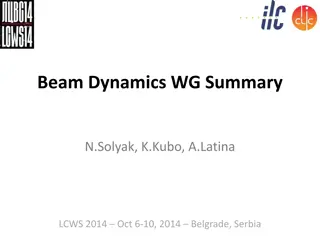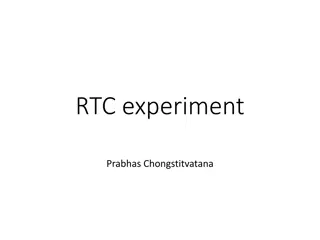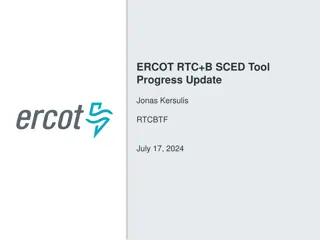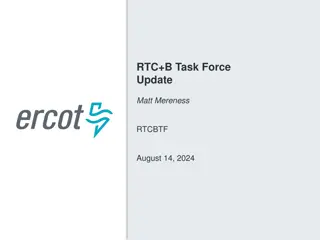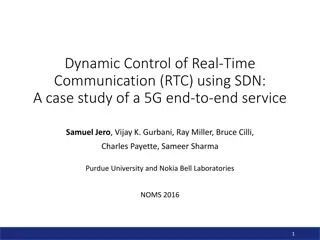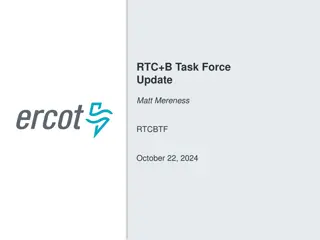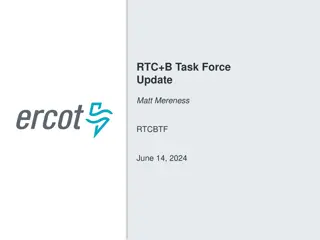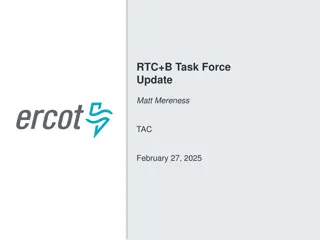RTC Simulation Tool Overview and Case Studies Market Analysis
This content provides an overview of the RTC Simulation Tool, including case studies on congestion, scarcity, reliability deployment, and pricing analysis. It delves into the simulator's key components, objectives, input-output mechanisms, system data, and simulation assumptions and limitations. The tool's primary developers and contributors are acknowledged, along with details on the framework for reviewing RTC pricing outcomes relative to traditional pricing models.
Download Presentation

Please find below an Image/Link to download the presentation.
The content on the website is provided AS IS for your information and personal use only. It may not be sold, licensed, or shared on other websites without obtaining consent from the author.If you encounter any issues during the download, it is possible that the publisher has removed the file from their server.
You are allowed to download the files provided on this website for personal or commercial use, subject to the condition that they are used lawfully. All files are the property of their respective owners.
The content on the website is provided AS IS for your information and personal use only. It may not be sold, licensed, or shared on other websites without obtaining consent from the author.
E N D
Presentation Transcript
RTC Simulation Tool Overview and Case Studies Market Analysis October 22, 2024
Agenda Overview of RTC Simulator Simulation Assumptions Case Studies Congestion Case 07/10/2023 Scarcity Case 09/06/2023 Reliability Deployment Price Adder (RDPA) Case 10/20/2023 Acknowledgements Jonas Kersulis + Raymund Lee: Primary Developers Ike Urquhart: Pricing run, modeling, sequential run logic Li Lau + Luke Gutierrez: Visualization application prototypes Sai Moorty: Whitepaper (Summary of RTC formulation), SME Zhengguo Chu: Supervisor and SME Dave Maggio: SME Jian Chen: SME 2 2 Public
Simulator Overview - KP1.1 (8) - ERCOT will work with stakeholders prior to RTC go-live to develop a framework and reporting to periodically review RTC pricing outcomes relative to pricing outcomes that would have been realized through the ORDC for a reasonable period of time. Core Inputs Outputs Optimization System Data GTBD AS Plan ASDC parameters MCL, VOLL System Outputs System Lambda Objective Function Resource Outputs LMPs Energy Awards AS MCPCs AS Awards Build and solve optimization problem Resource Data Status Resource Type Capacity and Ramping Limits AS Capability and Qualification Energy and AS Offers Transmission Outputs Constraint loading Constraint shadow price Transmission Constraints Shift Factors 3 3 Public
Simulation Assumptions and Limitations 4 4 Public
Simulation Assumptions and Limitations Only works for operating days post-ECRS implementation (06/10/2023) Each interval was simulated individually, with no dependence upon the results of previous interval simulations System parameters VOLL = $5000/MWh SWCAP = $2000/MWh Undergeneration Penalty = $7001.01/MWh Overgeneration Penalty = -$251/MWh ASDCs Created using the methodology presented during February RTCBTF mu = 3760 and sigma = 1180 AS quantities were taken from the relevant hour of the AS plan Energy Offers SCED step 2 energy offers Ancillary Service Offers Prevailing AS offers during the time of RTC SCED execution are being used as-is. Future results will use DAM AS offers. Proxy AS offer segment created using methodology presented during September RTCBTF Proxy AS offer floor is a configurable parameter (studies have used $0/MWh and $2000/MWh) 5 5 Public
Simulation Assumptions Ancillary Service Qualification Use qualified MW quantity. If qualified without a quantity, assume it is qualified for 9999 MW. Use qualification snapshot at the beginning of the operating day. Ancillary service ramp rates Assumed to equal real-time telemetered normal ramp rates HDL LDL Constraints 5/7 of regulation capacity counted towards HDL and LDL constraints Pre-RTC to RTC Status Mapping Pre-RTC Status Resource Type RTC Status ONREG, ONOSREG, ONDSRREG, ONFFRRRS All ON FRRSUP, FRRSDN GR, ESR ON ONRGL, ONCLR, ONRL, ONFFRRRSL, ONECL, FRRSUP, FFRSDN CLR, NCLR ONL OFFNS GR OFF ONRR, ONECRS GR ONSC All OUT 6 6 Public
Simulation Assumptions NCLR self-arranged quantities Assumed to equal telemetered real-time responsibility. Energy Storage Resources Combo model (GR/CLR), single model not implemented State of charge is not considered Combined Cycle Frequency Responsive Capacity Telemetry Assumptions Use today s NFRC telemetry to estimate Frequency Responsive Capacity RTC telemetry RespFactor HiRespLim LowRespLim Transmission constraints Use transmission constraints that were activated in real-time. 7 7 Public
Case Studies 8 8 Public
Case Study Congestion Case (07/10/2023) Congestion occurred in the South load zone during the solar ramp down. This caused Real-Time system lambda to reach as high as $4691.09/MWh. Operators released up to 700 MW ECRS and 1232 MW offline Non-Spin to manage congestion. System Lambda* *Pre-RTC trendline includes ORDC Adders 9 9 Public
Case Study Congestion Case (07/10/2023) Observing reduced system congestion under RTC Reduction in transmission limit violations Generally lower shadow prices (not strictly lower) Lower system-wide congestion rent Pre-RTC Congestion Rent = $14,147,639 RTC Congestion Rent = $4,668,712 System Congestion Rent COLETO_ROSATA1_1_SCO2EUL8 PAWNEE_SPRUCE_1_DELMSAN5 10 10 Public
Case Study Scarcity Case (09/06/2023) Narrative Low levels of dispatchable capacity resulted in Real-Time system lambda going above $1000/MWh for 70 SCED intervals between 15:00 and 20:15. System lambda was at $5001/MWh for 24 of these SCED intervals. ERCOT frequency dropped as low as 59.769 Hz and was below 59.91 Hz for more than 15 minutes, which triggered a declaration of EEA 2. As much as 132 MW of NSPIN, 2600 MW of ECRS, and 1100 MW of RRS were deployed to manage grid conditions. System Lambda* *Pre-RTC trendline includes ORDC Adders 11 11 Public
Case Study Scarcity Case (09/06/2023) Observations When energy prices are high, RTC prioritizes awarding energy and goes short on awarding ancillary services ECRS Awards NSPIN Awards ASDC HE 20 12 12 Public
Case Study Scarcity Case (09/06/2023) A key benefit of RTC is the reallocation of ancillary services which can help reduce congestion. This behavior is illustrated in the figure below showing a snapshot at 18:55. PAWNEE_SPRUCE_1_DELMSAN5 is at max shadow price ($4500/MWh) in RTC simulation and pre-RTC. Under RTC, more AS is allocated to resources located in the South to help with the congestion. These were Regulation, RRS, and ECRS. No Non-Spin was awarded in the RTC simulation this interval. Geographic distribution of AS Allocation at 09/06/2023 18:55 13 13 Public
Case Study RDPA Case (10/20/2023) Two resources were committed for operating hours between HE16 HE 24 due to a projected shortage in capacity. System Lambda* *Pre-RTC trendline includes Online ORDC Price Adder 14 14 Public
Case Study RDPA Case (10/20/2023) Under RTC, there is an RDPA for energy and each AS type RTC RDPA magnitudes were much lower for this day Same graph without showing pre-RTC RDPA 15 15 Public
Appendix 16 16 Public
Case Study Congestion Case (07/10/2023) A key benefit of RTC is the reallocation of ancillary services which can help reduce congestion. This behavior is illustrated in the figure below. 17 17 Public
